Ships the USS Helena CL-50, sailed with, during WWII.
Ships named below, are mentioned in a number of the CL-50 War Diary files.
USS O'Brien (DD-415) first found in USS Helena CL-50 War Diary on 3 September 1942,
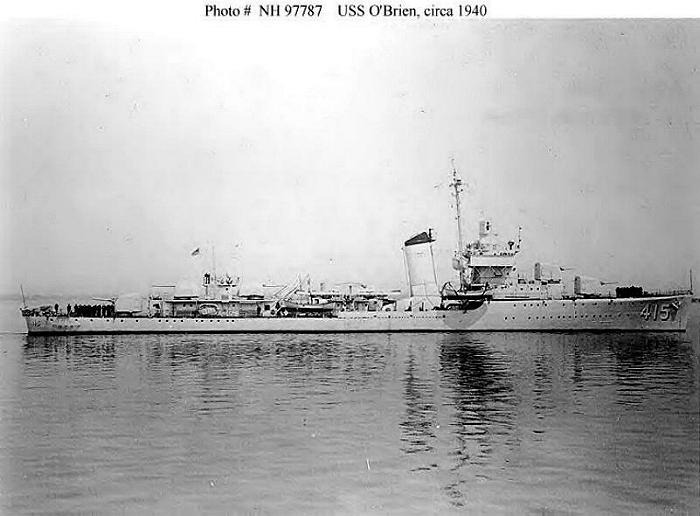
USS O'Brien (DD-415) was a World War II-era Sims-class destroyer in the service
of the United States Navy, named in honor of Captain Jeremiah O'Brien and his five
brothers, Gideon, John, William, Dennis and Joseph, who captured HMS Margaretta on
12 June 1775 during the American revolution. O'Brien was laid down at Boston Navy Yard,
Boston, Massachusetts, on 31 May 1938; launched on 20 October 1939; sponsored by
Miss Josephine O'Brien Campbell, a great-great-great granddaughter of Gideon O'Brien;
and commissioned on 2 March 1940, with Lieutenant Commander Carl F. Espe in command.
Since this warship was built in a drydock, along with the destroyers Walke, Lansdale,
and Madison, the christening and commissioning ceremonies were combined. |
History
Name: USS O'Brien
Builder: Boston Navy Yard
Laid down: 31 May 1938
Launched: 20 February 1939
Commissioned: 2 March 1940
Honors and American Defense Service Medal
awards: ("Fleet" clasp)
Asiatic-Pacific Campaign Medal (1 star)
World War II Victory Medal
Fate: Suffered structural damage as a result
of being torpedoed by I-19
15 September 1942, foundered on
19 October 1942 (all hands saved)
General characteristics
Class and type: Sims-class destroyer
Displacement:
1,570 long tons (1,600 t) (std)
2,211 long tons (2,246 t) (full)
Length: 348 ft, 3¼ in, (106.15 m
)
Beam: 36 ft, 1 in (11 m)
Draft: 13 ft, 4.5 in (4.07 m)
Propulsion: High-pressure super-heated boilers,
geared turbines with twin screws,
50,000 horsepower
Speed: 35 knots
Range: 3,660 nautical miles at 20 kt
(6,780 km at 37 km/h)
Complement: 192 (10 officers/182 enlisted)
Armament: 5 × 5 inch/38, in single mounts
4 × .50 caliber/90, in single mounts
8 × 21 inch torpedo tubes in two quadruple mounts
2 × depth charge track, 10 depth charges
World War II
After drydocking and repairs during the fall of 1941, O'Brien left Norfolk, Virginia
on 15 January 1942 along with the battleshipIdaho and the destroyer Mustin, and
then steamed for the Pacific Ocean. Transiting the Panama Canal on 20 January, the trio
of ships arrived in San Francisco, California, on 31 January.
O'Brien steamed with a convoy for the Western Pacific on 4 February 1942, but she
was forced to return when a collision with the destroyer Case damaged her port side.
Following repairs at the Mare Island Navy Yard, the destroyer steamed out again on 20
February, bound for Pearl Harbor. There Commander Destroyer Division 4 shifted his flag
to O'Brien on 5 March 1942.
After operating out of Pearl Harbor and patrolling the Hawaiian atoll, French Frigate Shoals,
O'Brien called at Midway Island in the latter part of March, escorting the seaplane tender
Curtiss there to evacuate civilians. The two warships returned to Pearl Harbor on 3 April.
After an increase and improvement of her antiaircraft batteries, she embarked passengers for
transportation to the Naval Air Station at Palmyra Atoll, and then steamed out on 18 April
with the destroyers Flusser and Mugford. The destroyer then joined convoys from San Diego
and San Francisco to escort them to American Samoa, arriving at Pago Pago on 28 April.
O'Brien was retained at Pago Pago for local escort work. On 26 May, she supported the
occupation of Wallis Island, previously taken over by the Free French, and then she joined the
auxiliary vessel Procyon on 19 June for the return voyage to Pearl Harbor. Operating out of
Pearl Harbor, the ship performed escort duty and acted as patrol and plane guard. She got
underway on 17 August with Task Force 17 (TF 17) to reinforce the South Pacific Force,
screening the tanker Guadalupe. |
Sinking.
While escorting a convoy of troop transports en route to Guadalcanal, the combined Task
Forces 17 and 18 were attacked by the Japanese submarine I-19 on 15 September 1942.
The aircraft carrier Wasp was sunk, and the battleship North Carolina and O'Brien
were damaged by a spread of six torpedoes from the submarine.
At 1452, O'Brien sighted smoke coming from Wasp. As a member of the aircraft
carrier Hornet'sASW screen, she made an emergency turn to the right. At about 1454,
while accelerating and swinging right, her lookouts spotted a torpedo two points forward of
the port beam, 1,000 yards (910 m) away. This torpedo then missed O'Brien close astern,
but while her crew's attention was concentrated on it, another torpedo hit her port bow.
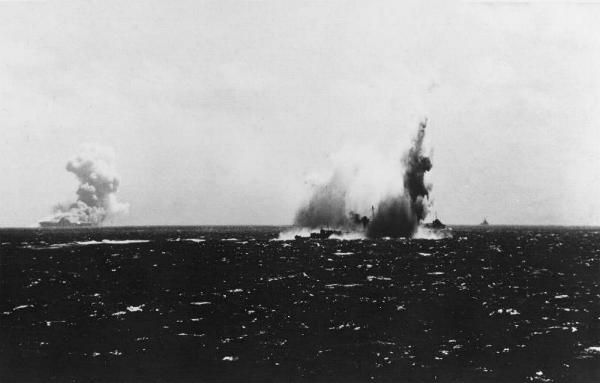
Torpedo from I-19 hits O'Brien.
USS Wasp can be seen burning in the background.
This explosion did little obvious damage, but it set up severe structural stresses throughout
the framework of O'Brien. She was able to proceed under her own power, and on
16 September she reached Espiritu Santo, where the sailors from Curtiss made temporary
repairs. O'Brien next steamed out on 21 September, bound for Noumea, New Caledonia,
for further repairs by the repair ship Argonne. Then, she steamed out on 10 October, bound
for San Francisco Bay.
O'Brien made it to Suva in the New Hebrides on 13 October, and then steamed out once
more on 16 October.The rate of leakage of seawater into O'Brien continued to increase,
and on 18 October it was necessary for O'Brien to head for the nearest anchorage. Large
amounts of topside weights were jettisoned, and preparations were made for abandoning the
ship, but her captain still thought that she could be taken intact to Pago Pago. However, at
about 0600 on 19 October, her bottom suddenly split open considerably, and her forward and
after hull portions began to work independently. At 0630, all hands except for a small salvage
crew abandoned, but half an hour later O'Brien was abandoned entirely. Just before 0800
she descended beneath the waves, and after steaming nearly 3,000 nautical miles (5,600 km)
since she had been torpedoed. All members of her crew were saved.
|
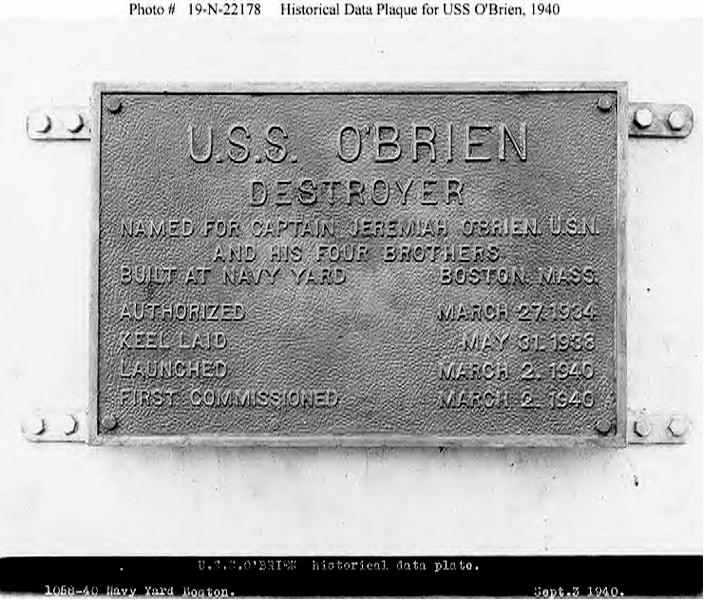
USS Mustin (DD-413) first found in USS Helena CL-50 War Diary on 4 September 1942,
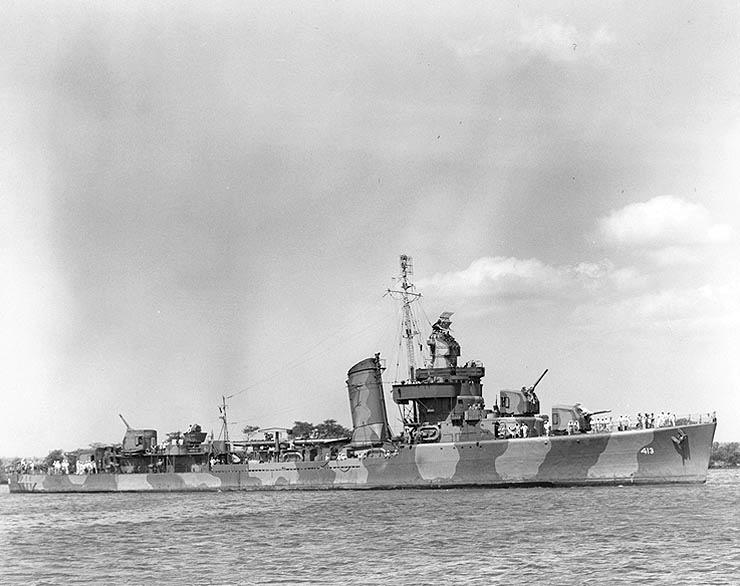
USS Mustin (DD-413) at Pearl Harbor, Hawaii on 14 June 1942.
Source: United States National Archives, Photo No. 80-G-10124.
Awards
Mustin received 13 battle stars for World War II service.
Technical Specifications
USS Mustin (DD-413) was a Sims-class destroyer of the United States Navy,
the first Navy ship of that name, in honor of Captain Henry C. Mustin (1874-1923),
a pioneer of naval aviation. Mustin was laid down on 20 December 1937 by
Newport News Shipbuilding & Dry Dock Co., Newport News, Virginia; launched on
8 December 1938; sponsored by Mrs. Lloyd M. Mustin, daughter-in-law of Captain
Mustin; and commissioned on 15 September 1939, Lieutenant Commander
James S. Freeman in command.
Mustin joined the Atlantic Fleet for the tense period of neutrality patrol
preceding American entry in World War II, playing her part in guarding the
western Atlantic. On 7 December 1941, she lay in overhaul at Boston Navy Yard,
Massachusetts, but put to sea next day escorting Idaho and Mississippi off to war.
She herself completed overhaul
in Charleston Navy Yard, South Carolina on 3 January 1942, transited the Panama
Canal on 20 January, and arrived at Pearl Harbor on 17 February for duty escorting
convoys between Hawaii and San Francisco until 3 April.
South Pacific, May 1942 – April 1943
A convoy mission to Samoa was completed at Pearl Harbor on 24 May. Mustin next
escorted a merchantman with reinforcements to Midway Island, threatened by the
Japanese attack which exploded while Mustin was returning to Pearl Harbor, where
she arrived on 5 June. Two days later, the destroyer sailed with Task Force 17 (TF 17),
searching for scattered Japanese survivors of the great battle of Midway. After a
negative search, the force returned to Hawaiian waters on 13 June, and Mustin began
2 months of training and patrols out of Pearl Harbor.
Mustin sailed on 17 August with TF 17, the Hornet group, bound for an important
role in the great sea warfare which wrested the Southwest Pacific from the Japanese. Her
group covered the southern approaches to Guadalcanal during the initial phase of fighting
there, then struck Buin, Faisi, and Tonolai from the air. In the Battle of the Santa Cruz
Islands on 26 October, Mustin rescued 337 of Hornet's survivors, and had the
grim duty of destroying the heavily damaged carrier with a full salvo of torpedoes. She
avenged the carrier in part by shooting down five enemy aircraft during the battle.
Patrol and convoy duty from Nouméa and Espiritu Santo alternated with task force duty, and
on 11 November, she joined TF 16 for the Naval Battle of Guadalcanal. On 25 December,
Mustin fired shore bombardment at enemy positions on Guadalcanal, to which she
had just escorted transports. In February 1943, she again guarded carrier operations off
Guadalcanal, then returned to patrol and escort duties until 14 April, when she returned to
Pearl Harbor.
Fate: Scuttled off Kwajalein, 18 April 1948 |
USS North Carolina (BB-55) first found in USS Helena CL-50 War Diary on 6 September 1942
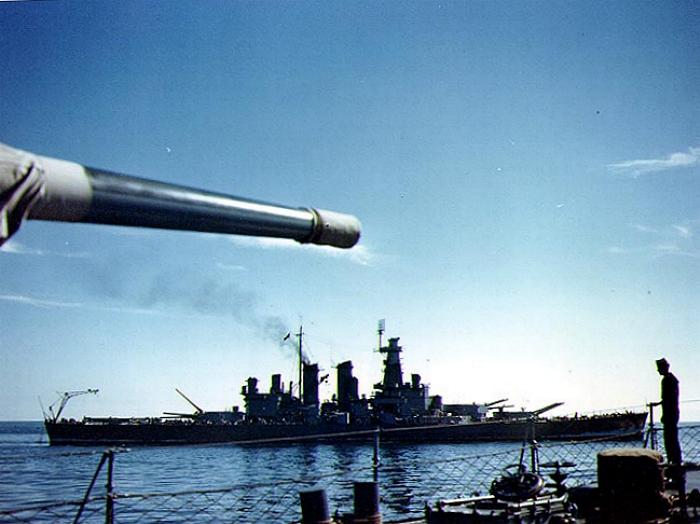
North Carolina in May 1941, putting to sea for trials
USS North Carolina (BB-55) was the lead ship of North Carolina-class battleships and the
fourth warship in the U.S. Navy to be named for the State of North Carolina. She was
the first newly constructed American battleship to enter service during World War II, and
took part in every major naval offensive in the Pacific Theater of Operations; her 15 battle
stars made her the most decorated American battleship of World War II. She is now a
museum ship and memorial kept at the seaport of Wilmington, North Carolina. |
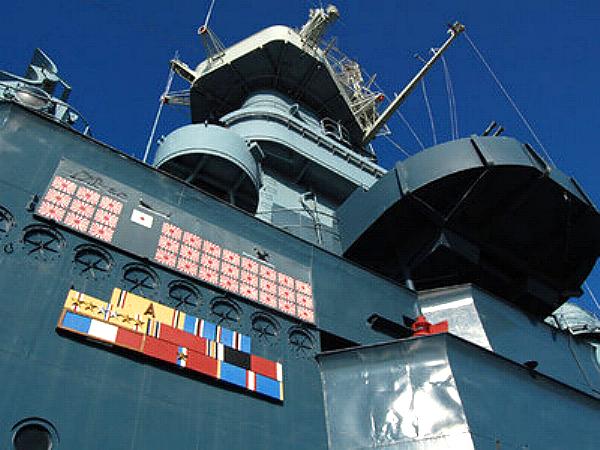
USS North Carolina (BB-55) Awards.
History
Name:North Carolina
Namesake: State of North Carolina
Ordered: 1 August 1937
Builder: New York Naval Shipyard
Cost: $76,885,750
Laid down: 27 October 1937
Launched: 13 June 1940
Sponsored by: Isabel Hoey,
daughter of Clyde R. Hoey,
governor of North Carolina
Commissioned: 9 April 1941
Decommissioned: 27 June 1947
Struck: 1 June 1960
Identification:
Hull symbol:BB-55
Code letters:NIBK
November India Bravo Kilo
Nickname(s): Showboat
|
Honors and
awards:
15 Battle Stars
American Defense Service ribbon
American Defense
Service Medal
American Campaign Medal ribbon
American
Campaign Medal
Asiatic-Pacific Campaign Medal ribbon
Asiatic-Pacific
Campaign Medal
World War II Victory Medal ribbon
World War II Victory Medal
Army of Occupation ribbon
Navy Occupation Medal
Presidential Unit Citation (Philippines)
Philippine Presidential Unit Citation
Phliber rib
Philippine Liberation Medal
PHL Independence Medal ribbon
Philippine Independence Medal
Status: Museum ship since
29 April 1962 in Wilmington, North Carolina |
General characteristics
Class and type: North Carolina-class battleship
Displacement:
37,484 short tons (34,005 t) (standard)
44,377 short tons (40,258 t) (loaded)
Length: 728.8 ft (222.1 m)
Beam: 108.3 ft (33.0 m)
Draft: 33.0 ft (10.1 m)
Installed power:
8 × boilers
121,000 hp (90,000 kW)
Propulsion:
4 × General Electric steam turbines
four propeller shafts
Speed:
28 knots (52 km/h; 32 mph) in 1942
26.8 knots (49.6 km/h; 30.8 mph) in 1945
Range: 17,450 nmi (32,320 km; 20,080 mi) at 15 knots
(28 km/h; 17 mph)
Complement: about 2,339 (144 officers and 2,195 enlisted)
Sensors and
processing systems:CXAM-1 radar beginning in
1940
Armament:
9 × 16 in (410 mm)/45 caliber Mark 6 guns
20 × 5 in (130 mm)/38 caliber dual-purpose guns
16 × 1.1 in (28 mm)/75 caliber anti-aircraft guns
—replaced by 15 × quad Bofors 40 mm guns (15×4)
and 48 × single Oerlikon 20 mm cannons (48×1)
Armor:
Side belt (over vital places): 12 in (30 cm)
Gun turret: 16 in (41 cm)
Main deck: 1.5 in (3.8 cm)
Armored Deck: 5.5 in (14 cm)
Third Deck: .75 in (1.9 cm)
Conning Tower: 16 in (41 cm)
Aircraft carried: 3 × Vought OS2U Kingfisher floatplanes
Aviation facilities: 2 × trainable catapults on her fantail |
North Carolina was laid down on 27 October 1937 at the New York Naval Shipyard
and launched on 13 June 1940, sponsored by the daughter of Clyde R. Hoey, the
Governor of North Carolina. She was commissioned in New York City on 9 April 1941,
with Captain Olaf M. Hustvedt in command. The first of the U.S. Navy's fast
battleships to be commissioned, she carried a powerful main battery of nine 16 in
(410 mm)/45 caliber Mark 6 guns. The ship received so much attention during her
completion and sea trials that she won the lasting nickname "Showboat".
North Carolina was limited to a standard displacement of 35,000 long tons (36,000 t)
by both the Washington Naval Treaty and the London Naval Treaty, to a beam of less
than 110 ft (34 m) by the width of the locks of the Panama Canal, and to a draft of
38 ft (12 m) so she could use as many anchorages and shipyards as possible.
Thus constricted, she proved a challenge to design.
As the first American battleship to be built in two decades, North Carolina was
given the latest in shipbuilding technology. Her propulsion was divided into four
main spaces, each with two boilers and one steam turbine per propeller shaft.
This resulted in fewer openings in watertight bulkheads and minimized the area
requiring protection by additional armor plate. Her propulsion systems (boilers/
turbines/shafts/propellers) suffered numerous teething troubles which were
reflected in long post-commissioning defect correction period which lasted Aprli-
December 1941. Her sister Washington suffered equally, and neither ship was
ever able to achieve their designed deep load speed of 28 knots. On the plus
side however, she was also one of just 14 ships to receive the early RCA CXAM-1
radar, and a strong (for the day) light anti-aircraft armament.
Aesthetically, her large tower forward, tall uncluttered stacks, and clean supe-
rstructure and hull were a sharp break from the elaborate bridgework, heavy
tripod masts, and casemated secondary batteries of World War I-era battleships.
Combined with her long sweeping flush deck and streamlined structure, she was
far more graceful not only than her predecessors but the nearly 50 ft (15 m) shorter
South Dakota-class battleships that succeeded her.
Service during World War II
North Carolina completed her final shakedown cruise in the Caribbean Sea before
the Japanese attack on Pearl Harbor. Early in 1942 she was scheduled to steam there,
but remained in the Atlantic Ocean for a few more months as a potential counter if the
German battleship Tirpitz began to attack supply and troop convoys destined for
Great Britain. By summer she was ordered to join the Pacific Fleet.
After intensive war exercises, North Carolina departed for the Pacific theater of
Operations. She was the first new battleship to arrive in the Pacific since the beginning of
the war, transiting the Panama Canal on 10 June, four days after the Battle of Midway in the
Central Pacific. She steamed to the port of San Pedro, California, and then to San Francisco
before proceeding to Hawaii. The ship arrived at Pearl Harbor on July 11 1942; according
to sailors there, North Carolina was "the most beautiful thing they had ever seen", and her
arrival in Hawaii greatly increased the morale of the Pacific Fleet. North Carolina departed
15 July in a task force of the aircraft carrier Enterprise, the heavy cruiser Portland, the light
cruiser Atlanta, and eight screening destroyers headed for combat in the South Pacific.
North Carolina joined the long island-hopping campaign against the Japanese by assisting
in the landing of U.S. Marines on the islands of Guadalcanal and Tulagi on 7 August 1942,thus
beginning the long battle for Guadalcanal. The only battleship in the naval force in the South
Pacific, she escorted the aircraft carriers Saratoga, Enterprise, and Wasp, surrounded
by their cruisers and destroyers. After helping to screen Enterprise in the air support force
for the amphibious landing, North Carolina guarded the carrier during her mission of
protecting the supply and communication lines to the Solomon Islands and Guadalcanal.
She participated in the Battle of the Eastern Solomons, on August 24-25, 1942. The Americans
struck first, sinking the carrier Ryujo. The Japanese counterattacked with dive bombers
and torpedo bombers, covered by fighters, striking at Enterprise and North Carolina.
In a mere eight-minute action, the ship's antiaircraft batteries shot down between 7 and 14 enemy
aircraft, her gunners remaining at their posts despite the jarring detonations of seven near misses.
One sailor was killed by strafing, but the ship was undamaged. Her antiaircraft fire was so heavy
that the officers of Enterprise asked, "Are you afire?"
North Carolina fired 841 5-inch (127 mm) shells, 1037 rounds of 1.1-inch (28 mm) shells, 7425
rounds of 20-mm shells, and 8641 rounds of .50 caliber machine gun ammunition during the attack.
The gunners of her 5-inch antiaircraft guns "...estimated that the rate of fire exceeded 17 rounds
per minute on all guns...", but reported both that vibrations hampered their optical range-finding
and the Mark 4 FD radar had difficulty acquiring targets. The protection North Carolina could offer
Enterprise was limited as the speedier carrier plunged ahead of her. Enterprise took three
direct hits while her aircraft severely damaged seaplane carrier Chitose and hit other Japanese
ships. With the loss of 100 Japanese aircraft, the U.S. Navy won control of the air and averted a
threatened Japanese reinforcement of Guadalcanal.
North Carolina next was assigned to protect Saratoga. Twice during the following weeks of support
to Marines ashore on Guadalcanal, North Carolina was attacked by Japanese submarines. On
6 September, she maneuvered successfully, dodging a torpedo that passed 300 yd (270 m) off the
port beam. Nine days later, while sailing with Wasp, Hornet, and ten other warships, North Carolina
suffered a torpedo hit on her port side just forward of her number 1 gun turret, 20 ft (6m) below
her waterline making a hole 32 ft by 18 ft, and killing five seamen. Torpedoes from the same salvo
from I-19 sank Wasp and the destroyer O'Brien. Skillful damage control by North Carolina's crew
and the excellence of her construction prevented disaster; a 5.6° list was righted in as many minutes,
and she maintained her station in a formation at 26 kn (30 mph; 48 km/h).
After temporary repairs in New Caledonia, the ship proceeded to Pearl Harbor to be dry docked for a
month for repairs to her hull and to receive more antiaircraft armament. Following repairs, she returned
to action, screening Enterprise and Saratoga and covering supply and troop movements in the Solomons
for much of the next year. She was at Pearl Harbor in March and April 1943 to receive advanced fire
control and radar gear, and again in September, to prepare for the Gilbert Islands operation.
.jpg)
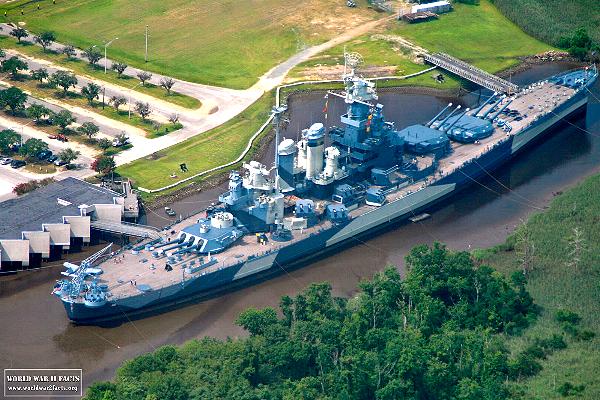
North Carolina Museum Ship. Wilmington, North Carolina. 2006
|








.jpg)
